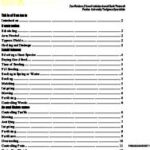Extension Publications
The Benefits of Pesticides, A Story Worth Telling (PPP-70)
Purdue Extension Publication
For decades, discussions among scientists and the public have focused on the real, predicted, and perceived risks that pesticides pose to people and the environment. Each use of a pesticide poses some level of risk, so it is not surprising that scientists, the regulated community, government officials, and the public need a realistic understanding of the risks associated with pesticide use. We must analyze how risk is assessed, identify the risks, and determine an appropriate level of concern.
Offering Sound Pest Management Advice to the Public (PPP-62)
Purdue Extension Publication
This publication emphasizes the importance of providing sound pesticide advice to customers. Good diagnostic skills are essential. You personally must know and understand the behavior of various pests and have a working knowledge of various control options available; and must ensure that your customers understand your recommendations.
Pesticides and Container Management (PPP-21)
Purdue Extension Publication
Proper management of pesticide containers generally is a straightforward procedure, but it requires careful thought and a proper attitude. Appropriate transportation and storage of pesticides help protect the environment, assure worker safety, save money, and avoid legal problems.
Pesticides and Fleet Vehicles Transporting Pesticides Safely (PPP-58)
Purdue Extension Publication
The care that you devote to maintaining your fleet goes a long way in conveying your commitment to quality service. This publication discusses the importance of vehicle maintenance, safe driving practices and how to respond to pesticide spills.
Bermudagrass for Southern Indiana Athletic Fields (AT-325-W)
Purdue Extension Publication
Turf quality on municipal athletic fields in southern Indiana is typically poor due to excessive traffic from football and soccer. But reseeding worn areas with some common grass varieties in late spring or late fall aren’t always successful. This publication explains how bermudagrass can be a potential solution to worn fields in southern Indiana.
Landscape Pesticide Application Equipment: A Guide to Selection and Calibration of Liquid Sprayers (PPP-47)
Purdue Extension Publication
Homeowners strive for beautiful and productive lawns, and sometimes, despite using good cultural practices, pests get the upper hand. When using pesticides to control pests it’s important to follow procedures and know how to use spraying equipment effectively.
Lawncare Pesticide Application Equipment: A Guide to Selection and Calibration of Granular Spreaders (PPP-46)
Purdue Extension Publication
Not calibrating lawn application equipment is like placing a meal in an oven and setting the temperature randomly. If the over is too high, the food is overcooked; too low, and it undercooked. This publication describes the basics of calibrating lawn care pesticide application equipment.
Building and Maintaining Soccer Fields in Indiana (AY-31-W)
Purdue Extension Publication
Soccer fields are the toughest of all turf areas to manage. This publication highlights several principles of construction and maintenance to help produce a soccer field with good playability and emphasis on player safety.






